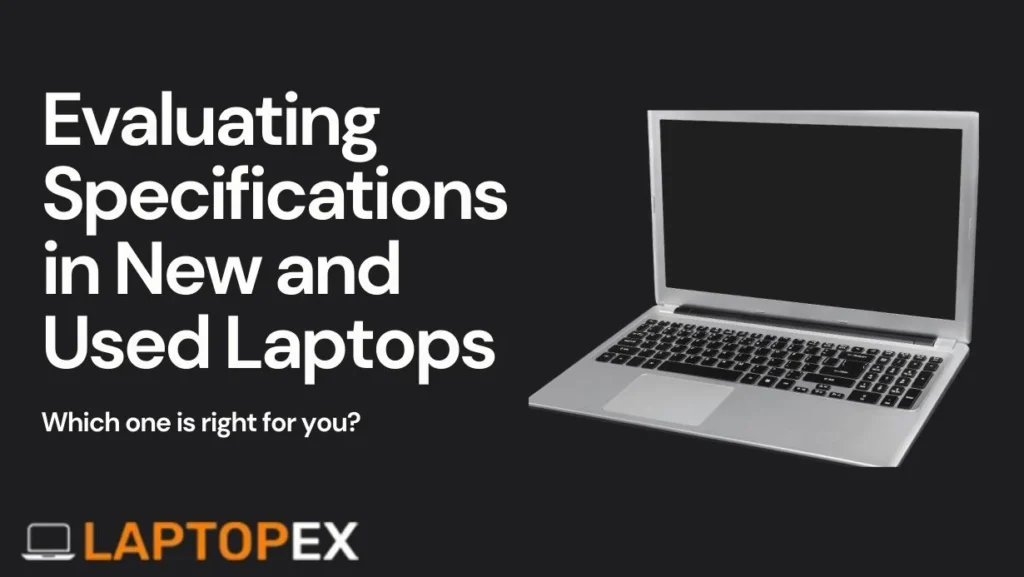How To Compare The Specifications And Features Of A Second-Hand Laptop To A New One
Hey there! Understanding the specs is critical when you’re searching for a laptop, whether brand new or second-hand. It’s like choosing the perfect tool for the job; we’re here to guide you through it. There are many options in the ever-changing tech world, and comparing specs helps you make intelligent choices.
This guide is your go-to for understanding the ins and outs of evaluating specifications in new and used laptops. We’re keeping it simple so you can find that spot between performance and saving some bucks. We’ll break down processor stuff, memory details, storage choices, screen quality, battery life, and more. By the end, you’ll have the lowdown to confidently choose the laptop that fits your needs, whether fresh out of the box or a seasoned second-hand gem. Let’s dive in and make your laptop journey a breeze!
Section 2: Key Features to Look for in a New and Used Laptop
In thoroughly evaluating specifications in new and used laptops, it is imperative to focus on critical features that significantly influence informed decision-making. Commence the analysis by closely examining processing power, considering processor speed and generation factors. Assessing memory capacity follows suit, ensuring it meets the requirements for routine tasks or demanding activities.
Transitioning to storage options, strike a balance between the advantages of conventional Hard Disk Drives (HDDs) and the swifter, more efficient Solid State Drives (SSDs). Achieving the optimal equilibrium between storage space and speed is paramount for a laptop’s overall performance.
Delve into the nuances of display quality and resolution, recognizing that a vibrant and sharp screen enhances the user experience. Additionally, explore the intricacies of battery life and the potential for future upgrades, as both aspects significantly contribute to a laptop’s durability and adaptability.
By emphasizing these key features, individuals gain the necessary insights to navigate the nuanced landscape of evaluating specifications in new and used laptops, ensuring a well-informed purchase aligned with specific needs.
Section 3: What to Think About When Checking Out Processor and Memory Specs
Let’s dive into the nitty-gritty of evaluating specifications in new and used laptops. When you’re eyeing a laptop, it’s essential to look at the processor and memory specs – these are the brain and memory of your device.
First up, the processor – it’s like the engine of your laptop. Check its type, how fast it goes, and which generation it belongs to. This matters because it affects how well your laptop can handle all the cool stuff you want to do.
Let’s talk about memory. We’re looking at RAM size and speed. Why? Because having enough RAM is like having a big desk to work on – the more, the better. It helps your laptop run lots of things at once without slowing down. Also, see if the laptop lets you add more memory later on. That’s like future-proofing your device, preparing it for whatever cool things come out next.
So, when checking out a laptop, watch these processor and memory specs closely. It’s like ensuring your car has the right engine and enough trunk space – you want it to fit your needs and be ready for the adventures ahead.
Section 4: Comparing Storage Options – HDD vs SSD
In our journey of exploring laptops, let’s unravel the best storage solution for you, whether a fresh-out-of-the-box companion or a reliable second-hand sidekick. The spotlight now shines on the critical choice between Hard Disk Drives (HDD) and Solid State Drives (SSD).
Evaluating Specifications in New and Used Laptops
Choosing the proper storage is like picking the perfect tool for a job. Here’s a breakdown of the two contenders:
- HDDs: Affordable and Spacious
- Cost-effective option
- Ideal for extensive file storage
- Suitable for various applications
- SSDs: Speedy and Efficient
- Superior speed and performance
- Durable and energy-efficient
- Ideal for swift data access
Making the Choice
The decision boils down to your usage preferences. If you’re all about quick data action, the zippy SSD might be your go-to choice. Second-hand laptops provide options for both HDDs and SSDs, giving you the flexibility to choose based on your needs. It’s worth noting that many new laptops default to SSDs for that extra performance boost right from the get-go.
Considerations for Your Decision
- Storage Needs: Assess how much space you require.
- Pros and Cons: Weigh the advantages and disadvantages of both options.
- Budget Constraints: Keep your financial considerations in mind.
By navigating through these factors, you’ll confidently select a Refurbished Laptop that meets your storage demands and aligns seamlessly with your budget, simplifying the evaluation of specifications in new and used laptops.
Section 5: Display Quality and Resolution Comparison
Let’s dig into the nitty-gritty of figuring out the specs when eyeing a new or used laptop. Our focus Today? The display quality and resolution comparison – it’s a game-changer!
First things first, look at the screen resolution. It’s like the pixels that make up your laptop’s world. Make sure it matches what you need for clear and sharp visuals. Watch out for dead pixels, funky colors, or any backlight drama that could spoil your view.
Next up is display technology. Think of it like the magic behind the scenes – go for IPS if you’re into vibrant colors and excellent angles. Oh, and don’t forget the screen size and shape; it has to match your style.
Why all this fuss? Your laptop isn’t just a number cruncher; it’s your window to the digital world. By carefully evaluating specifications in new and used laptops, you ensure that what you see on that screen is top-notch.
So, when searching for a laptop, keep these display deets in mind. Trust us, it’s worth it!
Section 6: Examining Battery Life and Upgradability of Laptops
Let’s dive into checking out the battery life and upgradability when weighing the pros and cons of new and used laptops. First up, we need to chat about the battery life. Now, why does this matter? Well, it’s pretty simple – the better the battery, the more you can take your laptop on adventures without worrying about it dying. So, when looking at a second hand laptop, give that battery an excellent check to ensure it’s up to snuff for your daily grind.
Now, let’s talk about upgradability. It’s like giving your laptop a chance to glow up. Some older laptops are like open books, ready for you to upgrade things like RAM or storage. This is cool because it means you can keep up with the times and stay caught up.
So, when exploring and comparing, pay close attention to the Evaluating Specifications in New and Used Laptops game. Look for a battery that suits your on-the-go needs, and keep an eye out for laptops that are open to upgrades. It’s all about making sure your laptop fits your lifestyle and can grow with you. Happy exploring!
Section 7: Additional Features to Consider in a Second-Hand Laptop vs New
All right, let’s get down to business! 🕵️♂️ Today, we’re talking about the nitty-gritty when it comes to choosing between a new and a second-hand laptop. We’re honing in on the crucial task of Evaluating Specifications in New and Used Laptops. Keep your eyes peeled for this golden phrase – it’s your roadmap.
First things first, examine your chosen laptop. Scrutinize it for wear, scratches, or any potential hiccups. Let’s spotlight that golden phrase again – Evaluating Specifications in New and Used Laptops. It’s like our secret weapon. Next, let’s dive into warranties. Think Laptopex and their stellar 3-year coverage – it’s a winner!
Time for a power move – consider the pre-installed software. It’s a game-changer. And guess what? Evaluating Specifications in New and Used Laptops is your go-to here. Moving on, let’s talk connectivity. Make sure your laptop buddies up well with your gadgets.
And here’s the grand finale – check if your laptop is upgradable. Can you beef up the RAM or storage? It’s like future-proofing your tech with a magic sprinkle of Evaluating Specifications in New and Used Laptops.
This section is your action plan for a savvy laptop choice. Keep that focus on Evaluating Specifications in New and Used Laptops, and you’re set to conquer! 🚀
Conclusion: Navigating Your Laptop Decision
All right, folks, we’ve covered a lot, and now it’s time to put it all together for a savvy laptop decision. Understanding why we compare laptop specs is like having the map to a treasure trove of tech wisdom.
In Section 2, we laid out the key features to check whether you\’re eyeing a brand-new beauty or a well-loved second-hand gem. And remember, in Section 3, when we dived into processor and memory specs? Yeah, we’ve got you covered on decoding that tech lingo.
The storage showdown – HDD vs SSD – was like choosing between good friends. Section 5 took us on a journey through displays, making sure your visuals are top-notch. Battery life and upgradability in Section 6 were like the icing on the tech cake, ensuring your laptop stands the test of time.
In Section 7, we unveiled the extra features of second-hand laptops, adding that sprinkle of uniqueness to your decision.
Armed with these insights, you’re all set to make a choice that suits your needs. So, dive in, explore, and here’s to your tech-savvy future!
Remember the golden phrase: Evaluating Specifications in New and Used Laptops. Happy laptop adventures! 🚀💻






